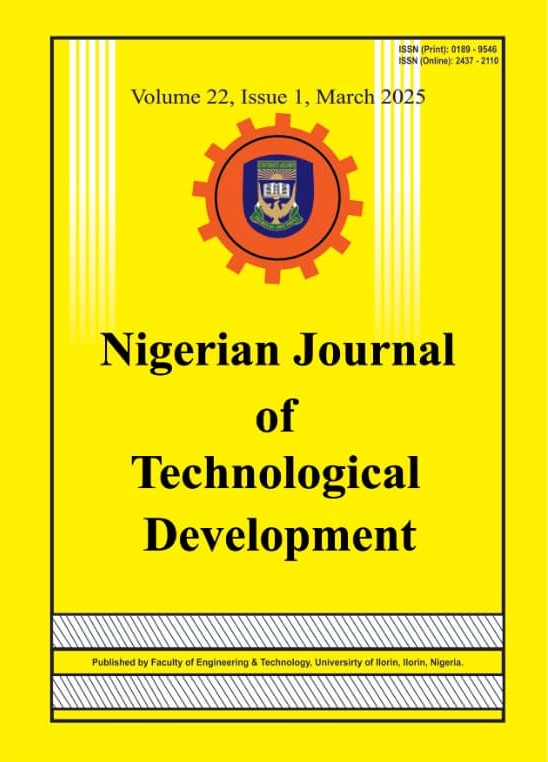DEVELOPMENT OF AN IMPROVED MOTORISED WHEELBARROW FOR CONSTRUCTION SITE OPERATIONS
DOI:
https://doi.org/10.63746/njtd.v22i1.3441Keywords:
Electric Motor, Energy Efficiency, Motorized assistance, Pivoted Handle, WheelbarrowAbstract
Efficient material handling is crucial for productivity and safety in the construction industry where tasks often involve transporting heavy loads across challenging terrains. Commonly used conventional wheelbarrows are limited by their manual operation, lack of adaptability to different user heights, and reduced efficiency on uneven surfaces. To address some of these inadequacies, this study introduces a redesigned motorized wheelbarrow to enhance ergonomics, performance, and versatility for construction sites in Nigeria. The improved design incorporates a 0.5 hp electric motor, pivoted handles for the user’s height range from 150 to 190 cm, and a detachable carriage with a steel frame supporting a maximum load of 136 kg. CAD simulations revealed a minimum safety factor of 9.380 for the wheelbarrow frame and vibration modes between 0.24 - 0.57 Hz. Performance tests demonstrated up to 70% higher speeds on smooth roads compared to sandy ground, maintaining functionality up to 30 kg in motorized operation.
References
Adeyemi, A., Oladele, A. S., Amusan, L. M., & Okolie, K. C. (2019). Impact of ergonomic practices on productivity and worker safety in construction. International Journal of Construction Management, 19(3), 237-247.
Ashwini, M. V., & Robionson, P. (2022). Development of Multiutility Wheelbarrow. Materials Today: Proceedings, 54(2), 386-389. ISSN 2214-7853. https://doi.org/10.1016/j.matpr.2021.09.454
Emmanuel, A. A., Nwofor, A., & Ijoma, A. (2022). Sustainable practices in the Nigerian construction industry: A review. Journal of Building Construction and Planning Research, 10(2), 103-115.
Haqiqi, Y. A., Suartika, I. M., & Setiawan, I. N. (2022). Rancang bangun gerobak sorong semi-otomatis berpenggerak motor dc dengan menggunakan metode pulse width modulation. Jurnal SPEKTRUM. https://doi.org/10.24843/spektrum.2022.v09.i04.p4
Kaur, G., Mishra, N., & Singhal, P. (2023). Construction Industry. Advances in Human Resources Management and Organizational Development Book Series (Print). ISBN: 9781668468807. https://doi.org/10.4018/978-1-6684-6878-4.ch010
Legner, S., & Ringbom, J. (2021). Improving the Conventional Industrial Wheelbarrow [University of SkÖvde]. https://www.diva-portal.org/smash/get/diva2:1576403/FULLTEXT01.pdf Assessed on 24/02/2025.
Leng, V., Kaamin, M., Ngadiman, N., Mokhtar, M., Ahmad, N. F. A., Hamid, N. B., Huiling, T., & Ting, T. Y. (2022). Construction of multipurpose wheelbarrow in facilitating civil work. AIP Conference Proceedings, 2644, 050016. https://doi.org/10.1063/5.0104462
Noor, H. M., Tukiran, A. S. M., Razali, A. S., Azwan, A. H. A. A., Janon, M. N., and Mohamad, M. A. (2024). The Modern Wheelbarrow. Multidisciplinary Applied Research and Innovation, vol. 5, no. 2, pp. 147–153.
Oke, A., Aigbavboa, C., & Khangale, T. (2017). Implementation of Sustainable Construction Practices in the South African Construction Industry. International Conference on Sustainable Materials Processing and Manufacturing, SMPM 2017, 121-128.
Schibye, B., Sogaard, K., Martinsen, D., & Klausen, K. (2001). Mechanical load on the low back and shoulders during pushing and pulling of two-wheeled waste containers compared with lifting and carrying of bags and bins. Clinical Biomechanics, 16(7), 549-559. https://doi.org/10.1016/S0268-0033(01)00039-0
Shittu, K. I., Bukar, B., & Usman, B. M. (2024). Design Fabrication and Performance Evaluation of Electrically Operated Wheel Barrow. International Journal of Advances in Engineering and Management, 6(2), 486–495. https://doi.org/10.35629/5252-0602486495
Silveira, F. da, Machado, F. M., Steinhaus, J. C. dos A., Amaral, F. G., & Romano, L. N. (2019). Conceptual Design Applied in the Development of an Ergonomic Wheelbarrow. Revista Ação Ergonômica, 13(2), 108–117. https://doi.org/10.4322/rea.v13i2.36.en

Downloads
Published
Issue
Section
License
Copyright (c) 2025 Nigerian Journal of Technological Development

This work is licensed under a Creative Commons Attribution-NonCommercial-ShareAlike 4.0 International License.
In accordance with the Copyright Act of 1976, which became effective January 1, 1978, the following statement signed by each author must accompany the manuscript submitted: "I, the undersigned author, transfer all copyright ownership of the manuscript referenced above to the Nigerian Journal of Technological Development, in the event the work is published. I warrant that the article is original, does not infringe upon any copyright or other proprietary right of any third party, is not under consideration by another journal, and has not been published previously. I have reviewed and approved the submitted version of the manuscript and agree to its publication in the Nigerian Journal of Technological Development." A copyright transfer form can be downloaded from the NJTD Website (http://njtd.com.ng/index.php/njtd). Author(s) will be consulted, whenever possible, regarding republication of material. All authors must have access to the data presented, and the authors and sponsor (if applicable) must agree to share original data with the editor if requested.





